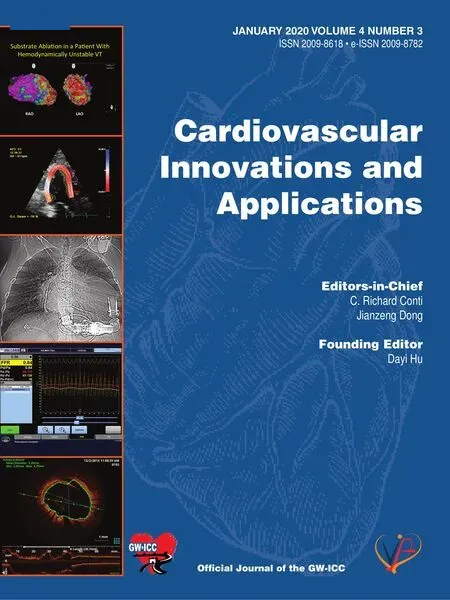Randomized Clinical Trials:Failure to Enter Patients
Let me start this editorial by indicating that I strongly support randomized clinical trials.
Recently,I had the opportunity to listen to a discussion about how to conduct a clinical trial.It occurred to me while listening to this discussion that there are many reasons why clinical trials never get done.
I will use as an example my personal experience to account for my failure to enter patients in an important clinical trial.But,f rst let me list a few impediments that apply to entry of patients at most sites.
lmpediments to Recruitment
Lack of Patient/Doctor Relationship
It is relatively easy to recruit patients who are cared for chronically by the physician conducting the trial.
In order to recruit stable ischemic heart disease patients,the principal investigator must not only see patients in hospital but should also have long term follow up commitment to the patient and the patients doctor.
Many of our patients are referred to us for in patient evaluation e.g.acute coronary syndromes,VT ablation etc.Once treated they are returned to their referring physician.Thus they are not really our patients,and the principal investigator needs to have concern about relationships with the referring Doctor.This aspect of recruitment must always be taken into account.
Patient Concerns
Patients referred for a clinical trial have several concerns that need to be discussed with the patient and referring doctor.For the patient these include “mistrust of researchers”,use of placebo,“the thought that they are part of an experimentation process” and concerns that their doctor is no longer making clinical decisions about their care.
Physicians Concerns
Some physicians think they have the answer to the clinical question being studied.Ethically these physicians cannot enter their patient in a randomized clinical trial.In contrast,if a physician does not think they know the answer to the clinical question being studied,then ethically they should enter the patient into a randomized controlled trial.The investigator who wishes to get an answer to the clinical question being addressed is doing the study for that very reason.
Travel to Recruitment Site by Patients
In many instances,patients must travel long distances to see a physician and participate in a clinical trial.This is not unique to our site but must be considered as an important impediment to recruitment,since costs related to transportation,and time off from work etc are important to many patients.
Study Drug or Device Concerns
This concern is intimately related to Impediment #1.Any clinical trialist recognizes that discussion with the patient about the study and the drugs or devices and the potential side ef fects used in the study is a major requirement.If this is not done by the recruiting person,the chances of recruitment are slim.
Randomization vs Specifi c Therapy
Many patients dislike the “randomization process” and use of placebo.Some patients have preference for a specif c therapy.Thus they need discussion of these topics before entry into the trial.
Lack of Colleague and Study Coordinator Participation
As far as I can tell,no principal investigator can recruit all of the patients required for a randomized clinical trial.The PI needs help and support from many other persons,i.e.the appropriate number of staff must be available.These persons must “buy into” the study and remain enthusiastic throughout the recruitment phase of the trial.This can only be accomplished if the PI takes the time to explain the details of the study to the staf f e.g.rationale for study,entry and exclusion criteria,safety of the agent tested and clinical endpoints of the study.
Personal Experience
In a recent NIH sponsored randomized clinical trial to which I was invited to participate,I thought it would be quite easy to enroll patients with stable ischemic heart disease since stable ischemic heart disease is a common and important clinical problem and these patients are frequently seen in our practice.The test drug for the trial was the anti-inf ammatory agent Methotrexate.
Methotrexate is a potent anti-inf ammatory agent commonly used by rheumatologists.The rationale for using the drug in stable ischemic heart disease patients is that the drug might diminish the amount of inf ammation associated with ischemic heart disease and therefore decrease symptoms and perhaps even decrease the amount of anti-angina agents patients were taking.
Outpatient Study
Since patients with stable ischemic heart disease are not usually admitted to hospital,recruiting these patients is done mainly in the clinic.However I forgot the fact that I did not work in the clinic but only on the inpatient service.Thus I did not have the opportunity to see patients in the clinic with stable ischemic heart disease and therefore I couldn’ t personally enroll anyone.Since I was not working in the clinic,the motivation for other physicians and study co-ordinators to enroll patients was sluggish.Thus I am to blame for our inability to recruit patients with stable ischemic heart disease for a project funded by the NIH and one I thought was worthwhile doing i.e.testing the use of methotrexate in these stable Ischemic heart disease patients.
Summary
I think it’s important for anybody trying to do randomized clinical trials to know the complete lay of the land,e.g.,know where your patients are being seen,who their doctor is,understand the limitations to participation that the individual patient has and spend time discussing with the patient and the patient’s doctor,the rationale and details of the study.
As a result of my not realizing that stable patients with IHD are only seen in the clinic,we had to withdraw from this clinical trial since,because of my error we could not enroll any patients for this important study.
 Cardiovascular Innovations and Applications2020年1期
Cardiovascular Innovations and Applications2020年1期
- Cardiovascular Innovations and Applications的其它文章
- Function of the Right Ventricle
- Physicians Leaving an Academic Position for Private Practice
- Associations between Vaspin Levels and Coronary Artery Disease
- Serum lrisin:Pathogenesis and Clinical Research in Cardiovascular Diseases
- Does Coronary Microvascular Spasm Exist? Objective Evidence from lntracoronary Doppler Flow Measurements During Acetylcholine Testing
- A Giant Right Atrial Myxoma with Blood Supply from the Left and Right Coronary Arteries:Once in a Blue Moon
